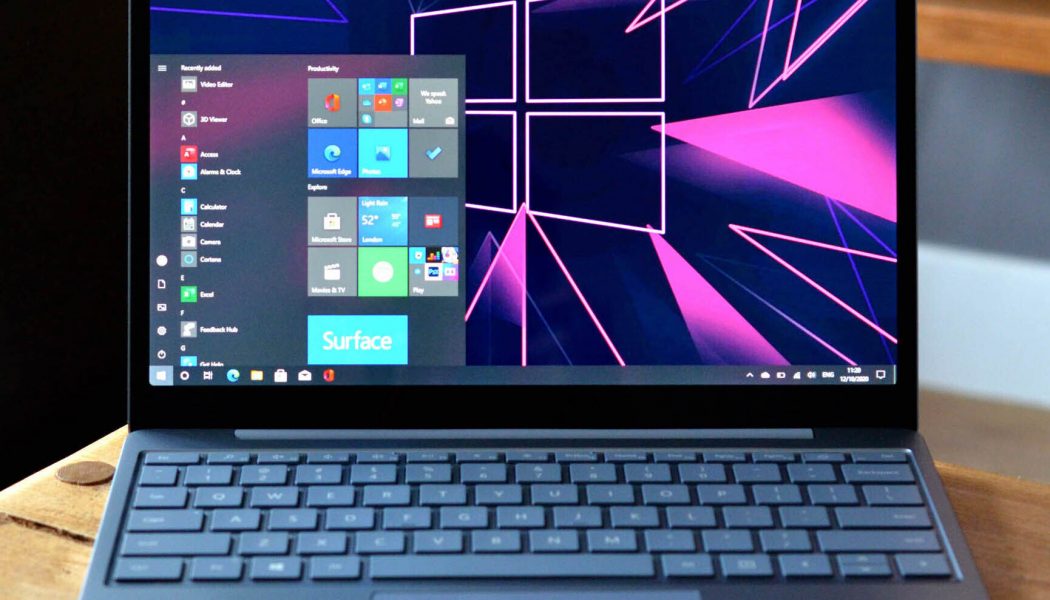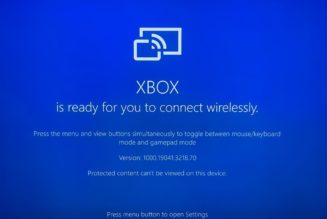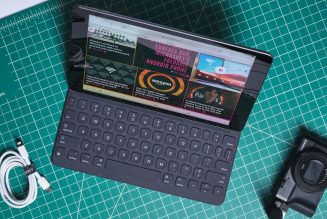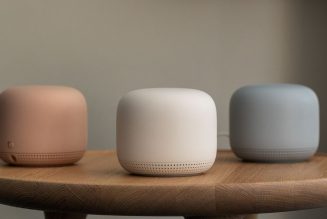I don’t hate using the Surface Laptop Go. It didn’t give me any problems. But I do have an issue with it, philosophically.
I really liked the Surface Laptop 3; I’m looking forward to an eventual Surface Laptop 4. Microsoft hasn’t announced one, though. Instead, it’s announced the Surface Laptop Go, a smaller, lower-priced laptop. It’s intended to be a budget option that competes with Chromebooks and other student-y offerings.
Well, “budget.” There’s an asterisk.
There are three models of the Surface Laptop Go, and I can really only see myself recommending one of them in good conscience. The base model is $549, and it only includes 4GB of RAM and 64GB of storage. I don’t see why you would buy that — even students are going to fill up 64GB in a second, and you can buy budget laptops like the Acer Aspire 3 with twice the RAM and storage (and a bigger, better screen) for the same price or the Acer Aspire 5 for just a bit more. The next model ($699) includes 8GB of RAM and 128GB of storage. I also have a problem with this one: $699 is more than I recommend spending on a laptop for kids (there are plenty of solid options under $400), but I would advise any adults or older students to look for more than 128GB of storage in a Windows laptop. It’s not enough for most people, and you can get at least 256GB for much cheaper.
And then there’s the model I have, which is the one that actually looks usable on paper. It has 8GB of RAM and 256GB of storage, in addition to the same quad-core Core i5-1035G1 available across the line. But it also costs $899, which means it’s competing with very good laptops. And I just don’t think it competes well.
Part of the premium is certainly for the Surface brand and design. The Go weighs just 2.45 pounds, making it noticeably lighter than the 13-inch Surface Laptop 3 (2.89 pounds), MacBook Air (2.8 pounds), and 13-inch MacBook Pro (3.1 pounds). That makes it the lightest ever Surface Laptop; it feels almost weightless.
On the lid is the same lustrous Windows-adjacent logo that adorns other Surface Books, Surface Laptops, and Surface Pros. But compared to those, the Laptop Go feels a bit like a toy. The top and keyboard cover are aluminum, but the base is made of what Microsoft calls “polycarbonate composite resin system with glass fiber.” It’s plastic. The base is made of plastic. Its rubbery texture reminds me of the outsides of Amazon’s Fire HD tablets, which regularly sell for around $100. The keyboard and touchpad, while very functional, also have a plastic-y texture and feel like budget affairs.
There are a few other areas where Microsoft seems to be cutting some costs. The keyboard isn’t backlit, which is a really weird omission from a $900 laptop. The camera isn’t compatible with Windows Hello. And the port selection (the same as the Surface Laptop 3’s) is limited to Microsoft’s proprietary charging port, an audio jack, a USB-C, and a USB-A.
:no_upscale()/cdn.vox-cdn.com/uploads/chorus_asset/file/21953640/twarren-surfacelaptopgo-19.0.jpg)
But the biggest area of compromise is the display. I’m generally a huge fan of 3:2 screens, and this display did afford some extra real estate; I was always able to work in multiple windows and tabs without zooming out. That said, the 12.45-inch touchscreen has just 1536 x 1024 resolution. That’s better than 720p but really below today’s standards. The 10.5-inch Surface Go 2 offers 1920 x 1280, and even the 10.1-inch $300 Lenovo Chromebook Duet manages 1920 x 1200. So in this case, Microsoft hasn’t provided a ton of extra vertical screen space. It’s more so shaved the sides off a traditional 1920 x 1080 display. If you’re looking for an excellent 3:2 touchscreen and don’t want to pay extra for the Surface Laptop 3, I highly recommend Acer’s $629 Chromebook Spin 713, if Chrome OS meets your needs.
There are some things I like a lot about the Laptop Go. There’s a fingerprint reader built into the power button (only on the $699 and $899 spec models), which is in a convenient location at the top-right corner of the keyboard, and it works quickly and reliably. And the audio was also a nice surprise. It’s about average for laptop speakers, which is much better than I was expecting from such a small product. The speakers don’t get loud enough to replace an external device, but my music sounded nice, and the percussion delivered a nice punch.
The Core i5-1035G1 is a year old at this point, but it’s still a competent chip for this type of laptop. (That’s another reason I find the base model bizarre: pairing a processor like this with 64GB of slow eMMC flash storage and a paltry 4GB of RAM feels like putting a car engine on a bicycle.) This system will be just fine for all of your office tasks, emails, video calls, and streaming. Nothing got hot, and I only ever heard the fans when I was running Adobe Premiere Pro, an uncommon task for this type of computer. The processor comes with Intel’s UHD integrated graphics, which means it’s not a good choice for gaming.
Speaking of Premiere Pro, the Laptop Go took an hour and nine minutes to export a five-minute, 33-second 4K video. Obviously, we wouldn’t expect a thin-and-light midrange system to do exceptionally well on that task, but the result underscores the fact that you’ll want to skip this product if you ever see yourself needing to do demanding work like this. For context, last year’s XPS 13 with a Core i7-10710U and UHD graphics took 24 minutes to complete the same task.
I’d hoped that we might see great battery life — that’s sometimes a perk of small lower-powered devices like this — but I only got six hours and 13 minutes of my daily office workload (which includes a load of 12 to 24 Chrome tabs and spreadsheets, a couple of apps, including Slack and Spotify, and various downloads) on Better Battery (Microsoft’s recommended profile) with the screen around 200 nits of brightness. That’s better than I get with the MacBook Pro and the MacBook Air but worse than plenty more powerful laptops that last me over seven hours, including the 13.5-inch Surface Laptop 3.
:no_upscale()/cdn.vox-cdn.com/uploads/chorus_asset/file/21953658/twarren-surfacelaptopgo-1.0.jpg)
Microsoft also says the Laptop Go supports fast charging. My test unit was decent; it took 52 minutes to charge up to 60 percent with Microsoft’s brick. I ran that test with the computer on to simulate a real-world scenario as best as possible. The laptop will certainly juice faster while it’s off.
There’s nothing I hate about the Surface Laptop Go. It’s quite portable, it looks nice, and it works just fine as a daily driver for schoolwork or everyday multitasking. But Microsoft has cut some corners. And with those corners cut, I don’t understand why this laptop is still $900.
At that price, you can buy a number of outstanding laptops that don’t compromise nearly as much. For $779, you can get an HP Envy x360 with the same RAM and storage, a six-core processor with great integrated graphics, all-day battery life, and a standout keyboard and display. For $749, you can get an Acer Swift 3 with 512GB of storage, a 3:2 screen, and way more ports. If you would consider a Chromebook, the $629 Chromebook Spin 713 is excellent in almost every way. I could go on and on.
All of these computers are a bit heavier than the Go but still quite portable — and they don’t ask as many sacrifices in return for that portability. They all have backlit keyboards, bigger and better displays, better port selections, and the look and feel of premium competitors.
:no_upscale()/cdn.vox-cdn.com/uploads/chorus_asset/file/21953649/twarren-surfacelaptopgo-10.0.jpg)
Plus, if you’re willing to spend a little bit more, you’re in the territory of XPS 13s, MacBooks, and Surface Laptop 3s. (The latter is old enough now that you can snag a sale price on some configurations if you keep an eye out.)
It’s understandable to cut corners for a good price. Some (like the lack of facial recognition) are understandable at $900. But this laptop doesn’t fit into today’s market. It’s too expensive to compete in the budget space, and it makes too many compromises to rise to the top of the midrange. When it goes on sale, maybe take another look.










